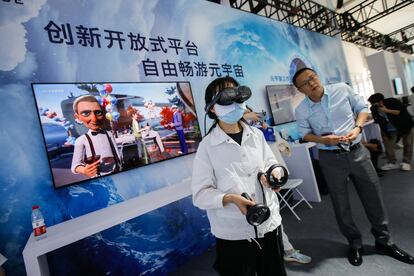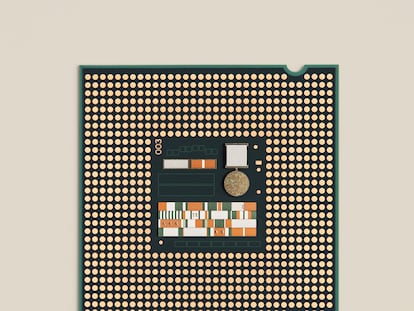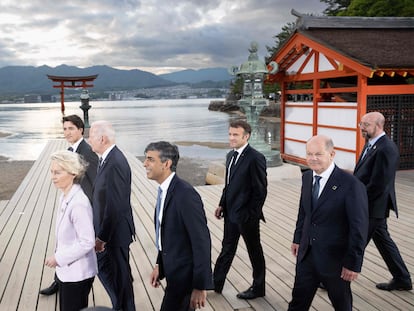Amid tech war with US, China redoubles AI and microchip efforts
As it seeks ‘self-sufficiency’ in the face of curbs imposed by Washington, China has brought together key figures at a technology forum in Beijing


China doesn’t want to be left behind in the development of artificial intelligence (AI) and semiconductors — two key elements in the global race for technological superiority, which is a major source of geopolitical tension with the United States. Aware that these two fields will be crucial to China’s economic and military future, Beijing is doubling down on efforts to find domestic solutions, at a time when Washington is out to limit Chinese access to the leading-edge technology the country needs to produce high-tech microchips. Amid big-money investment and calls from Chinese President Xi Jinping for “self-sufficiency” in science and technology, China’s strategy is in part focused on the creation of a collaborative environment that promotes faster development and ups the rate at which the Asian giant is catching up with the West.
“In comparison with developed countries, there is still a gap” in a range of areas integral to progress in AI, Mei Jianping of China’s Ministry of Science and Technology said on Friday, during a speech at the ZGC Forum. At the technology fair, which is being held in the Beijing district of Zhongguancun, a tech hub on the outskirts of the Chinese capital, AI is one of the hot topics. During his appearance, Mei called for an “exchange of ideas” and for all actors to contribute to placing “the next generation of AI in China,” and the country’s scientific and technological industry, on a par with the rest of the world.
Given the implications of the technology being discussed at the ZGC Forum, there is a clear political subtext to the conference, which is hosting events of all kinds: on sustainable development, financial technology, smart cities, the search for young entrepreneurs capable of “changing the world,” and the importance of innovation in state-run companies. In a presentation on AI, Dr. Yu Yue, of the Strategic Alliance for Technological Innovation in the Chinese Artificial Intelligence Industry, declared that the country would boost its technological growth by establishing a nationwide “network” of AI developers. “We want every computing center to achieve high-quality development,” he said. “And, horizontally, we want to connect computing centers to carry out a wide-ranging collaboration, constructing an extensive network that ensures AI technology can adopt a new model of development.”
To mark the kick-off of the ZGC Forum on Thursday, President Xi sent a letter that did not go into detail, but — without explicitly mentioning U.S. restrictions — highlighted the need for greater global collaboration. “As a new round of sci-tech revolution and industrial transformation continues to evolve, mankind needs international cooperation, openness and sharing more than ever in order to address common development problems,” Xi wrote, according to Xinhua, China’s official state news agency. The forum’s opening day witnessed addresses by renowned figures, such as Microsoft co-founder Bill Gates. “China will be able to make unique contributions to sharing its technologies and its lessons,” Gates said in a speech given via video link, per Chinese state media.
The forum is being held against the backdrop of tension between the U.S. and China, with relations hitting a low ebb due to repeated altercations over Taiwan, in addition to the February incident that saw the U.S. shoot down an alleged Chinese spy balloon that flew over American airspace without permission. In recent weeks, however, there have been some signs of a “thaw” — the word used by U.S. President Joe Biden during last weekend’s G7 summit in Hiroshima.
Further evidence of a potential improvement in relations came in the form of a meeting between China’s commerce minister, Wang Wentao, and his U.S. counterpart, Gina Raimondo, on Thursday. The talks, described by the American government as “candid,” saw the pair discuss the blows each country has struck against the other in the microchip sector. Wentao “expressed key concerns on the U.S.’s China policies on economy and trade, and semiconductors, as well as issues concerning export control and outbound investments review,” Xinhua said. In turn, Raimondo spoke of her concern over China’s growing restrictions on U.S. interests in the Asian country, such as a recent ban on the use of semiconductors produced by the American firm Micron in key infrastructure projects.
The move by Beijing has been interpreted in part as a response to Washington’s October decision to curb exports of microchip-manufacturing technologies to China, to avoid Chinese development of cutting-edge weapons. These microprocessors are also necessary in the field of AI, and the development of other state-of-the-art technologies such as smart electric vehicles. What’s more, Taiwan is significantly linked to the stand-off, as it produces 60% of global microchips, and 90% of the most advanced variants (it is capable of building three-nanometer chips; China, meanwhile, is playing catch-up). In an unusually blunt rebuke in March, Xi accused the U.S. of leading a Western strategy of “containment, encirclement and suppression” against China, in an attempt to undermine the country’s development.
At the ZGC Forum, there was an atmosphere of confidence over the future. “We’ll overcome this problem soon – we’ve done the same at previous points in our history,” said Huo Jiaqi, 23, a postgraduate student who spoke to EL PAÍS at the stand occupied by the Beijing University of Posts and Telecommunications, one of the country’s most prestigious educational institutions in the fields of cable and wireless communications, IT and electronic engineering. Surrounding him, in an enormous space devoted to exhibiting technological advances, there was a little bit of everything: smart humanoid robots, police robots, drones, and metaverse avatars strutting about on an LED screen.
Sign up for our weekly newsletter to get more English-language news coverage from EL PAÍS USA Edition
Tu suscripción se está usando en otro dispositivo
¿Quieres añadir otro usuario a tu suscripción?
Si continúas leyendo en este dispositivo, no se podrá leer en el otro.
FlechaTu suscripción se está usando en otro dispositivo y solo puedes acceder a EL PAÍS desde un dispositivo a la vez.
Si quieres compartir tu cuenta, cambia tu suscripción a la modalidad Premium, así podrás añadir otro usuario. Cada uno accederá con su propia cuenta de email, lo que os permitirá personalizar vuestra experiencia en EL PAÍS.
¿Tienes una suscripción de empresa? Accede aquí para contratar más cuentas.
En el caso de no saber quién está usando tu cuenta, te recomendamos cambiar tu contraseña aquí.
Si decides continuar compartiendo tu cuenta, este mensaje se mostrará en tu dispositivo y en el de la otra persona que está usando tu cuenta de forma indefinida, afectando a tu experiencia de lectura. Puedes consultar aquí los términos y condiciones de la suscripción digital.
More information
Archived In
Últimas noticias
Most viewed
- Sinaloa Cartel war is taking its toll on Los Chapitos
- Oona Chaplin: ‘I told James Cameron that I was living in a treehouse and starting a permaculture project with a friend’
- Reinhard Genzel, Nobel laureate in physics: ‘One-minute videos will never give you the truth’
- Why the price of coffee has skyrocketed: from Brazilian plantations to specialty coffee houses
- Silver prices are going crazy: This is what’s fueling the rally










































